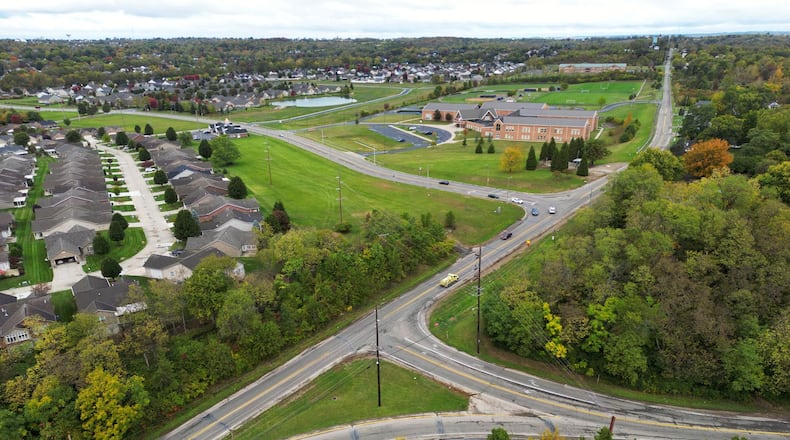“Never have these investments been more critical for our economy, our safety and our future,” OKI’s CEO Mark Policinski said. “They are an investment in both the people and projects of our region. As global competition incessantly challenges us, our infrastructure must be dramatically improved.”
The federal funds will go to four projects:
- The estimated $100 million North Hamilton Crossing project received nearly $6 million for two roundabouts, new sidewalks and multi-use paths on North B Street/NW Washington Boulevard and West Elkton Road. There is a mandatory 21% local match or $1.5 million.
- MetroParks of Butler County can finish the final two gaps of the Great Miami River Trail within their jurisdiction with $1.75 million in federal money and a $437,355 local match. The gaps are in Fairfield, Lemon and Liberty townships.
- Fairfield is getting $1.7 million — the 30% local match is $744,981 — to add a multi-use path adjacent to Pleasant Avenue between Hunter Road and Wessel Drive. The project includes adding curbs, storm sewer, water, signage, traffic calming features and crosswalks.
- Fairfield will also receive $750,306 to fill a gap in its portion of the Great Miami River Trail from Waterworks Park and the roundabout at River and Gray roads in Marsh Park. The city has a 50% local match.
North Hamilton Crossing is a joint project with the city of Hamilton and the Butler County Transportation Improvement District. They are still hammering out the exact route of the massive project and several options are still in play. Hamilton’s Assistant Director of Engineering Allen Messer told the Journal-News even if the entire project takes as long as 20 years to complete, this first grant-funded leg is crucial but independent of the whole plan.
“We still have two river crossing options, two rail crossing options and then three through the neighborhoods, the roundabout project that got funded is the same in all three scenarios,” Messer said. “It’s a stand-alone, even if North Hamilton Crossing were to never materialize it’s a needed improvement of efficiency and safety through those intersections.”
Some people will be displaced as part of the entire project, but Messer said right-of-way needed for this project is all vacant land. He said they expect to start construction in 2026 but for utility relocation “people could see activity as early as ‘25.”
With this grant they have culled a total of $17.9 million, the city’s contribution is $9.75 million, the state $2 million and the TID $250,000.
TID Executive Director Dan Corey said they don’t have the “preferred alignment” picked yet but the “eastern most and western most portions of North Hamilton Crossing have been defined but the middle from B Street over to Route 4 is still being discussed with three different alternatives.”
The northwestern end is the new roundabout location and the other end is at Ohio 129 and Hampshire Drive. The very rough cost for the entire project is $100 million, but Corey said “it really depends which alignment we pick, there are several million dollar differences between alignments.”
MetroParks can now finish what other grant funding couldn’t, close the final gaps in their portion of the Great Miami River Trail. Upon its completion, trail users will be able to ride 95 continuous miles from Fairfield to Piqua. Trail users can currently access 11 miles of trail between Rentschler Forest MetroPark and Waterworks Park in Fairfield, and close to 70 miles of trail stretching from Middletown to Piqua.
“MetroParks of Butler County is elated to receive the Surface Transportation Block Grant as this secures the final piece of funding necessary to complete our portion of the GMRT” MetroParks’ Executive Director Jackie O’Connell said. “We are grateful to OKI for recognizing the importance of this regional trail system and are confident these funds will provide innumerable opportunities for recreation, transportation and economic development in Butler County and beyond.”
The Butler County commissioners gave the park system $2.5 million worth of American Rescue Plan Act funding for the trail extension and $450,000 for the rural parks. MetroParks has also received other grant funding for the trail. Construction will begin in 2025 and should be complete in two years maybe a little longer.
OKI also gave Fairfield $750,306 to take the Great Miami River Trail from Waterworks Park inland to Marsh Park. City officials said unlike many sections of the GMRT Fairfield’s segment will be unique in that it will move away from the river, providing “stunning views” of Marsh Lake and improved connections to the surrounding neighborhoods.
The other Fairfield grant is for $1.7 million to build a multi-use path on Pleasant Avenue to connect neighborhoods with two major anchors on each end, the Fairfield Town Center area on one side and a direct connection to Harbin Park on the other.
“The City is excited and appreciative of the funding to advance these two critical projects,” City Manager Scott Timmer said. “With these funds, we will improve the connectivity of our neighborhoods with major park facilities, Fairfield’s Town Center, and other regional trail networks. The opportunity to improve our connectivity is crucial for continued vitality in Fairfield.”
OKI for a second time rebuffed Butler County Engineer Greg Wilkens’ request for funding to widen Ohio 747 in Liberty Twp. He was looking for $7.4 million for the $11.4 million project, he planned to use his own funds and a $2 million contribution from the township.
“Those grants are competitive,” Wilkens said. “There’s certain language in the application, there isn’t a high accident history on that, there’s not a lot of truck traffic up at that stretch, environmental justification is a problem to get, creation of jobs, probably not. So it makes it tougher to get that money even though that project’s needed.”
About the Author

